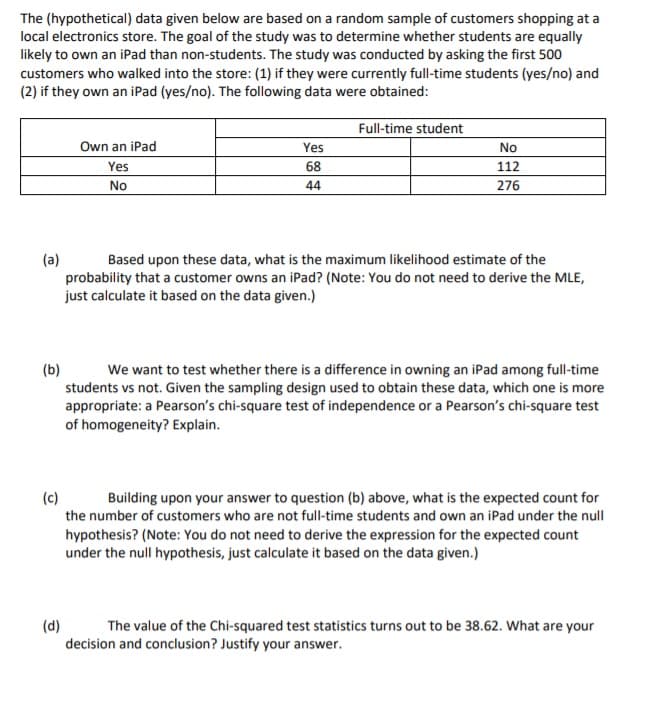The (hypothetical) data given below are based on a random sample of customers shopping at a local electronics store. The goal of the study was to determine whether students are equally likely to own an iPad than non-students. The study was conducted by asking the first 500 customers who walked into the store: (1) if they were currently full-time students (yes/no) and (2) if they own an iPad (yes/no). The following data were obtained: Full-time student Own an iPad Yes No Yes 68 112 No 44 276 (a) Based upon these data, what is the maximum likelihood estimate of the probability that a customer owns an iPad? (Note: You do not need to derive the MLE, just calculate it based on the data given.)
The (hypothetical) data given below are based on a random sample of customers shopping at a local electronics store. The goal of the study was to determine whether students are equally likely to own an iPad than non-students. The study was conducted by asking the first 500 customers who walked into the store: (1) if they were currently full-time students (yes/no) and (2) if they own an iPad (yes/no). The following data were obtained: Full-time student Own an iPad Yes No Yes 68 112 No 44 276 (a) Based upon these data, what is the maximum likelihood estimate of the probability that a customer owns an iPad? (Note: You do not need to derive the MLE, just calculate it based on the data given.)
Functions and Change: A Modeling Approach to College Algebra (MindTap Course List)
6th Edition
ISBN:9781337111348
Author:Bruce Crauder, Benny Evans, Alan Noell
Publisher:Bruce Crauder, Benny Evans, Alan Noell
Chapter5: A Survey Of Other Common Functions
Section5.3: Modeling Data With Power Functions
Problem 6E: Urban Travel Times Population of cities and driving times are related, as shown in the accompanying...
Related questions
Question

Transcribed Image Text:The (hypothetical) data given below are based on a random sample of customers shopping at a
local electronics store. The goal of the study was to determine whether students are equally
likely to own an iPad than non-students. The study was conducted by asking the first 500
customers who walked into the store: (1) if they were currently full-time students (yes/no) and
(2) if they own an iPad (yes/no). The following data were obtained:
Full-time student
Own an iPad
Yes
No
Yes
68
112
No
44
276
(a)
probability that a customer owns an iPad? (Note: You do not need to derive the MLE,
just calculate it based on the data given.)
Based upon these data, what is the maximum likelihood estimate of the
(b)
students vs not. Given the sampling design used to obtain these data, which one is more
appropriate: a Pearson's chi-square test of independence or a Pearson's chi-square test
of homogeneity? Explain.
We want to test whether there is a difference in owning an iPad among full-time
(c)
Building upon your answer to question (b) above, what is the expected count for
the number of customers who are not full-time students and own an iPad under the null
hypothesis? (Note: You do not need to derive the expression for the expected count
under the null hypothesis, just calculate it based on the data given.)
(d)
decision and conclusion? Justify your answer.
The value of the Chi-squared test statistics turns out to be 38.62. What are your
Expert Solution
This question has been solved!
Explore an expertly crafted, step-by-step solution for a thorough understanding of key concepts.
Step by step
Solved in 2 steps with 3 images

Knowledge Booster
Learn more about
Need a deep-dive on the concept behind this application? Look no further. Learn more about this topic, statistics and related others by exploring similar questions and additional content below.Recommended textbooks for you

Functions and Change: A Modeling Approach to Coll…
Algebra
ISBN:
9781337111348
Author:
Bruce Crauder, Benny Evans, Alan Noell
Publisher:
Cengage Learning

Holt Mcdougal Larson Pre-algebra: Student Edition…
Algebra
ISBN:
9780547587776
Author:
HOLT MCDOUGAL
Publisher:
HOLT MCDOUGAL

Functions and Change: A Modeling Approach to Coll…
Algebra
ISBN:
9781337111348
Author:
Bruce Crauder, Benny Evans, Alan Noell
Publisher:
Cengage Learning

Holt Mcdougal Larson Pre-algebra: Student Edition…
Algebra
ISBN:
9780547587776
Author:
HOLT MCDOUGAL
Publisher:
HOLT MCDOUGAL